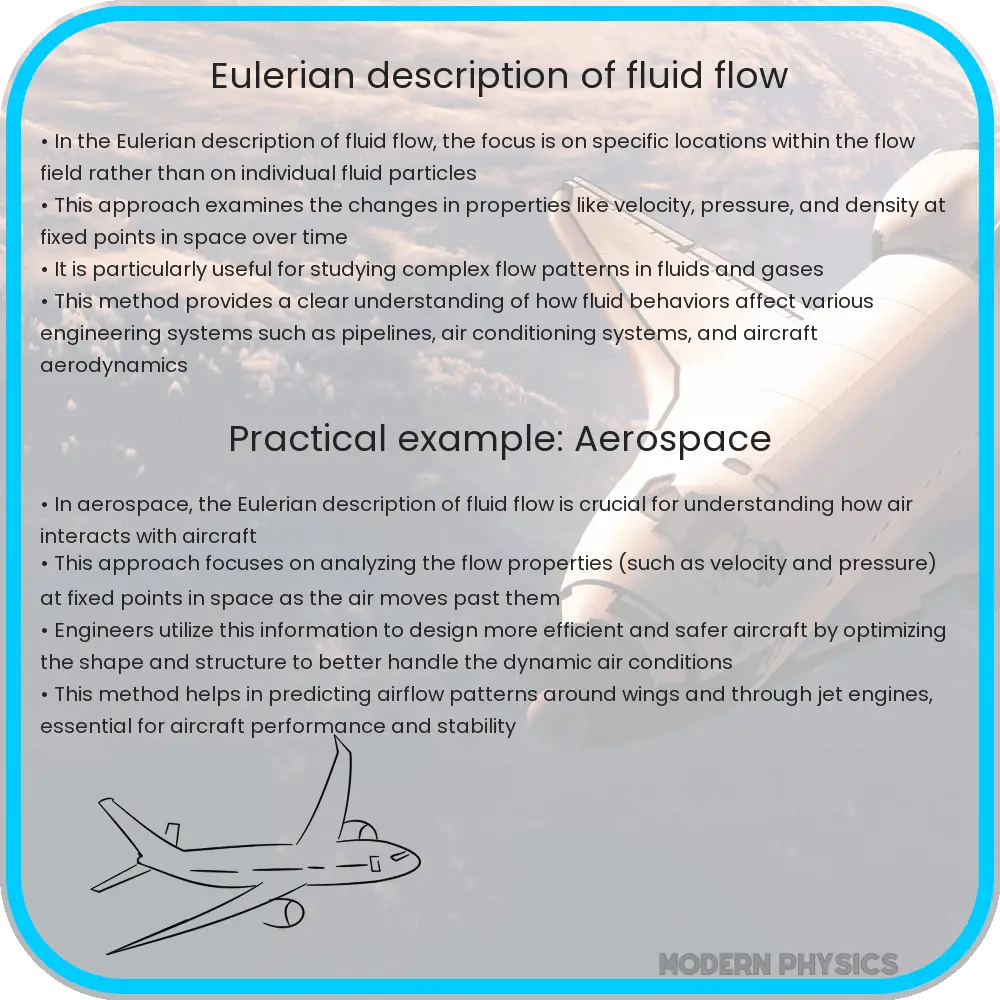Explore Eulerian Fluid Flow: Dive into the dynamics, patterns, and applications in meteorology, oceanography, and engineering with Euler’s equations.

Eulerian Fluid Flow: Unveiling the Dynamics and Patterns
Fluid dynamics, a fundamental aspect of both classical and modern physics, is crucial for understanding a vast array of natural phenomena and engineering applications. Within this field, Eulerian fluid flow analysis stands as a pivotal concept, offering insights into the behavior of fluids in motion. Named after the Swiss mathematician Leonhard Euler, this approach provides a framework for examining fluid dynamics from a fixed spatial perspective.
At the heart of Eulerian analysis is the Eulerian frame of reference. Unlike the Lagrangian method, which tracks individual fluid particles, Eulerian analysis focuses on specific points in space, observing how fluid properties change over time at these fixed locations. This approach is particularly useful in scenarios where tracking individual fluid particles is impractical due to the complex nature of fluid flow.
Understanding the Fundamentals: Euler’s Equations of Fluid Motion
Euler’s equations of fluid motion are the cornerstone of Eulerian fluid flow analysis. These equations, derived from Newton’s second law of motion, describe the relationship between the velocity field of the fluid and the forces acting upon it. The basic form of Euler’s equation in a non-viscous, incompressible fluid is expressed as:
ρ(∂v/∂t + v · ∇v) = -∇p + f
Here, ρ represents the fluid density, v the velocity field, p the pressure, and f the body forces (such as gravity) acting on the fluid. The term ∂v/∂t denotes the temporal change in velocity, while v · ∇v represents the convective acceleration.
Applications and Implications
The implications of Eulerian fluid flow analysis are vast and diverse. In meteorology, it aids in understanding atmospheric dynamics, crucial for weather prediction and climate modeling. In oceanography, it helps in analyzing ocean currents and their impact on climate and marine life. Furthermore, Eulerian analysis is pivotal in engineering applications such as aerodynamics, where it assists in designing more efficient aircraft and vehicles.
One of the fascinating aspects of Eulerian fluid dynamics is the emergence of complex flow patterns. Turbulence, a ubiquitous phenomenon in fluid flow, is a prime example. Despite being a topic of extensive research, turbulence remains one of the most challenging aspects of fluid dynamics to understand and predict. Euler’s equations, in their various forms, provide a foundational framework for tackling these complexities.
Moreover, Eulerian analysis is integral in understanding and predicting the behavior of environmental phenomena like oil spills, air pollution dispersion, and the spread of wildfires. This approach allows for the modeling of these events in a more realistic and accurate manner, offering critical insights for environmental protection and disaster management.
Delving Deeper: Pattern Formation in Fluid Flow
Eulerian fluid flow analysis not only addresses the macroscopic behavior of fluids but also sheds light on the intricate patterns formed during fluid motion. These patterns, ranging from simple laminar flows to complex turbulent eddies, are essential in understanding fluid dynamics. For instance, the study of vortices, which are circular patterns of fluid motion, has significant implications in understanding weather systems and the aerodynamics of flight.
Computational Fluid Dynamics: A Modern Approach
In contemporary research and application, Eulerian fluid flow analysis is often complemented by Computational Fluid Dynamics (CFD). CFD uses numerical methods and algorithms to solve and analyze problems involving fluid flows. Computers are used to perform the calculations required to simulate the interaction of liquids and gases with surfaces. By using Euler’s equations as a foundation, CFD allows for more detailed and complex analyses, including turbulent flow, which is challenging to study through traditional analytical methods.
CFD applications are vast, encompassing weather forecasting, car and aircraft design, and even in the medical field for simulating blood flow in the human body. This synergy of Eulerian analysis and computational power is a testament to the enduring relevance of Euler’s work in the digital age.
Challenges and Future Directions
Despite its extensive applications, Eulerian fluid flow analysis is not without challenges. One major issue is the complexity involved in solving Euler’s equations for turbulent flow. Turbulence is inherently chaotic and unpredictable, making it difficult to model accurately. Additionally, the approximation methods used in Eulerian analysis may not always capture the nuances of real-world fluid behavior.
Future research in Eulerian fluid dynamics is geared towards enhancing the accuracy of turbulence models and developing more efficient computational methods. Advances in computer technology, coupled with innovative mathematical approaches, promise to overcome current limitations and open new frontiers in fluid dynamics research.
Conclusion
Eulerian fluid flow analysis, rooted in Euler’s groundbreaking equations, continues to be a cornerstone of fluid dynamics. Its application extends from understanding natural phenomena like weather patterns and ocean currents to practical engineering solutions in aerodynamics and environmental management. Despite challenges, particularly in modeling turbulence, ongoing advancements in computational methods are steadily unlocking new potentials. As we continue to explore and understand the complex world of fluid dynamics, Eulerian analysis remains an indispensable tool, bridging the gap between theoretical physics and real-world applications.
